|
What is syntax - or "grammar"?
It could be repeated here:
- It works as the binding force between parts of
a sentence as "the whole".
As a binding force it represents a higher d-degree than
the separate "words" in our model.
- It is a testimony of the multidimensional network
in the brain connecting sense in sentences.
- It is the translation to linear order
of motor articulation from this multidimensional sense.
This transformation is no easy task.
In peoples' oral speech there may be many breaks, deviations,
new starts of a sentence etc. To transform thought-nets
to linear, written sentences may be one of the obstacles
for many to express themselves literary.
Syntax concerns many levels as in a level chain, both the
primary word class categories, in itself a whole dimension
chain as proposed here, and the secondary and tertiary...
("fractional") developments within these word
classes.
As embracing many levels it gets a character
of depth.
Such structures could be resembled with main roots and
side roots of plants as "word-bushes" or word-trees
with ramifications in mould of memory... - or the same
above the ground: syntax then as a "high" level.
What is got from the sky is of course equally necessary
for the development of plants!
As a geometric illustration of complex structures we could
perhaps use the pentagon: the 5-sided regular figure,
which if all corners get connected with each other give
new pentagons in the middle etc. (See figures at end of
this file.)
From all these aspects Syntax appears
as a high-dimensional level as it was supposed to be, representing
d-degree 4 in the big level chain.
However, syntax varies very much between different
languages - also between closely related ones, and it changes
over time, sometimes over few decades.
We expect a deeper level of speech production
to be more universal, showing more similarities, being closer
to the unity of mankind. It obviously isn't. (At least in
any simple sense.)
The opposites could perhaps be united if we look
at the two gradients of the big level chain in analysing
speech: D-degree 4 of syntax will correspond to d-degree
1 of phonemes, and d-degree 4 in the gradient from phonemes
will correspond to d-degree 1 of syntax.
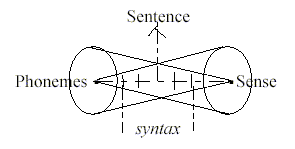
Sentences developed along a z-axis in the figure?
Phonemes and rows of phonemes are referred to "lexicon"
and the most differentiating level between languages.
Orders of phonemes are more closely coupled
to semantic sense, much closer than word order and syntax:
in Swedish: sak-ask-ska means "thing" -
"box" - "shall". A "wrong"
linear order of words in the syntax of a certain language
may still be passably understood.
Sense as centre in one gradient develops to order of phonemes,
here illustrated by the circles, which also may represent
differentiations among languages. Phonemes as centres in
the other gradient develop to semantic sense in opposite
direction.
Hence, syntax as a deep binding force
among word categories (in the middle step) represents simultaneously
very developed linear rows of phonemes. Syntax as more superficial,
developed to linear structure, represents a deep, high-dimensional
level of phonemes.
The gradients could be identified with the two opposite
dimension chains of Structure and Motions
(motions also geometrical characterized) in the dimension
model applied here. Motions from phonemes (individual sounds).
Structure from the whole sense:

A related aspect is that outer poles of d-degree 4 in our
model are 0 and 00 of d-degree 5 (the "whole").
They define Direction. These poles meet in d-degree 0/00
of Motions (with poles out of d-degree 1 called "motions
to and from each other").
This could imply a direct jump to speech
from 0/00 (equivalent 5'), viewed in synthesizing direction?
Compare that the cranial motor nerve to
the tongue departs from "mdulla oblongata", a
very deep level in the brain (in many aspects representing
d-degree 4 in analysis of levels of the brain; coming files.)
In the two gradients the debranched degrees
in the dimension chain of structure outwards will represent
the phoneme sequences of motions in inward direction: 0-1-2-3-4-5.
We have one (1) d-degree of motion in
d-degree 4. (Proposed identified as L-waves on the physical
level. Cf. the opposite directions in individual phonemes
as implosive / explosive phases in Saussure's analysis.)
This motion, proposed as linear in d-degree
4, may be interpreted as the start of sound rows in the
opposite gradient from phonemes.
Hence, sequences of phonemes in speech
and development of the syntax in the other gradient and
direction, could be expected as more or less simultaneous,
parallel processes.
There is of course nothing universal in
which phonemes or word order of grouped ones that are picked
from the stockpile. Yet, these views are perhaps part of
the reasons why we could look at syntax as of high d-degree.
Syntactic elements as lexical pieces:
It has been suggested in an earlier file that the way a
certain language expresses such things as genitive, plural,
passive form, past tense etc. are stored in the brain as
lexical pieces, this then making up a secondary level
above the stores of nouns, verbs, adjectives...
Note that the "lexical" gradient
from phonemes and morphemes stretches along the whole gradient
of levels to the developed sense, to the opposite gradient
from Sense.
It's an assumption here that children
immediately apprehend whole situations and their immanent
"grammar" - in the semantic interpretation of
this word.
Compare also some children's ability to
talk backwards (CEL) - revealing a sense for an immanent
or underlying duality in directions.
Thus, what may be universal in "grammar" would
be that which is common in human minds: the geometrical
sense in such categories as genitive, plural, passive form,
past tense etc. - together with the conceptions corresponding
to the more elementary word classes. Fundamental geometries
expressing Direction - Mass, forms - Space, Locations -
Time, Distances-Singular/plural and other such properties.
(Different aspect from secondary and
third levels of differentiations may be more or less developed
by different groups.)
Hence, a genitive - or a plural - or a locative may be
identified as universal pieces of grammar, corresponding
to geometries which are interpretable in terms of the dimension
model as proposed here. While the different ways to express
genitives etc. in a language seems mainly "lexical"
- having a deep history of developments behind it.
Chomsky has (earlier) seen syntax as a property of a certain
language, independent of sense, as pure grammar.
We can judge the construction of a sentence as grammatically
wrong even it doesn't make sense.
That's right to a certain degree. However,
it obviously depends on our possibility to recognize what
is meant to be nouns, verbs, adjectives etc. It's relying
on the level of what we call primary word class differentiations.
A simple row of not interpretable morphemes or "words"
cannot be judged as ungrammatical.
It's necessary to recognize geometries
as such as having semantic sense.
The structure of our brains shows the same
organization as the main "categories of aspects"
in the radial ARAS system upwards towards cortex and a corresponding
system downwards the body, in the "circular" cortex
with transversal connections, in columns of nerve sells
in cortex for special sensory/motoric areas etc. (About
the brain in coming "Biology" files.)
One universal feature seems to be the need of a verb
for a relating "full" sentence. "It is
beautiful." Why "is"? Compare
cries - first unbarred sounds. The need of a verb could
be compared with the need of vowels among consonants for
a single word.
It has also a parallel in the pathways
of signals in the brain through nerve fibres versus nerve
cells as enclosed units.
In Arabic much of the grammatical differentiations
- belonging to Syntax - are said to be expressed in the
vowels, while the substance of sense lies in the consonants
(LB). Vowel changes in word stems of IE have the
similar function.
This aspect: vowels - verbs - syntax looks
like an example of how d-degree 4 could be expressed in
different steps of the big level chain, along the main axis
of the two gradients. (About differentiation
of phonemes here.)
Features of the dimension model: what could be universal:
a) That which is said above: the concepts behind "word
categories" as fundamental aspects on the world.
b) The truism that verbs are connected with adverbs, nouns
with their properties - per definition: in interpretations
here:
d-degree 4 with 1,
d-degree 3 with 2.
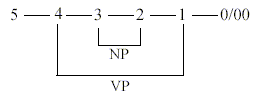
(They may also be regarded as two different "levels":
polarization 5 → 4 + 1 the
deeper step.)
It corresponds partly with division of
sentences in noun phrases and verb phrases, the NP-VP-division.
(One part of it the transformation from anti-parallel direction
in d-degree 4 to a perpendicular relation in d-degree 3:
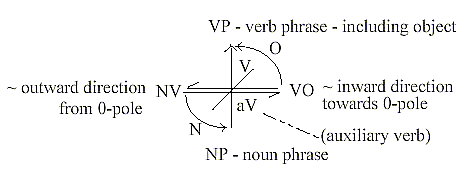 ) )
Two first things in the model allow obviously for differentiated
syntax and word order:
- Verbs may be apprehended as said
above in d-degree 4 of Direction, or polarized into active,
passive as poles of d-degree 3, or as radial connections
subject - object in d-degree step 3-2 or as motions in d-degree
0/00 - or even as just linear in d-degree 1.
- Nouns may be apprehended as 0-poles,
first centres, or as encircled enclosed units in d-degree
3 (pole 3a) - or perhaps as "nounified" properties...
To these ambiguities come the 3 main directions in the
chain: outwards - inwards - or vertical as in the
loop model.
Linear order:
The "correct" linear, 1-dimensional order of
a sentence should be the last factor established in Syntax,
seen from the gradient of Sense.
For instance: Starting with an adverbial:
is the right order of noun and verb then V→-N
or N → V in a certain language?
A phrase like "Fortunately he
didn't take that job" starts with an adverbial.
The same phrase in Swedish grammar would be "Fortunately
took he not that job".
The division of sentences in noun and
verb phrases (NP-VP) may tell us about underlying connections
between parts of sentences but not about linear word order.
A strong wish of an object may give the object first place.
Start of a sentence - what is needed?
- It needs some kind of purpose or aim, in this sense direction
semantically.
- It needs verbs as it needs vowels, as written above.
- It demands surely too a "topic" as a kind of
centre but not necessary as first word.
Chomsky talks about the sovereign position
of the Subject in a sentence, maybe pronouns developed to
subjects, with nouns as centres. We could translate it here
to the need of a 0-pole (with reference to Big Bang!). A
0-pole from which follows direction outwards. (It's implied
also in the very act of speaking, opening the mouth for
an utterance.) Some may however regard the direction outwards
as the most essential happening.
- The start is obviously also depending on the speech situation,
context, references - speech as answers, as re-actions.
Word order SVO... and attributes (LL):
Linguists have tried to group languages according to dominant
use of word order for Subject - Verb - Object in main phrases.
The order varies much within the same language family.
VSO: e. g. Celtic, Arabic, Maori)
SOV: e. g. Persian, Turkish, Japanese)
SVO: e. g. most IE languages, Finnish-ugr., Chinese)
Hence alternatives:

It seems to agree approximately with what could follow as
possibilities from our dimension chain of word classes above
- and may also depend on the ambiguities mentioned above
in interpretations of verbs and nouns in the model here.
Something of a trend has been found in
the position of attributes (A) in these 3 word orders (LL):
In VSO: A after, in SOV: A before, in SVO: A before or after.
It just seems as a natural trend to place attributes close
to the noun classes S and O, if possible away from the verbs.
(?)
Such a dominating order (among V, S, O) may perhaps be
regarded as the typical one in a certain language for construction
of a "telling" phrase, a statement. Then through
"transformational rules" (NC) give all
other possible phrases in that language? This approach however
concerns obviously a certain language, not universal features.
Are there any "universals" in the very principle
for these transformations? As a stepwise rearrangement?
Order of steps in the proposed dimension
chain for word classes has of course no simple connection
with word order in typical sentences, if such are recognized.
Yet, a stepwise development should in
some sense be implicated in our model, as polarization steps.
The place of debranched degrees however, according to the
loop model, makes it ambiguous: e.g. where to position adverbials
and where attributes, - in the first steps 5 →
4 → 3 or "the other
way around'.
Together with the mentioned other ambiguities
in dimensional interpretation of verbs and (Pro)-nouns in
the chain, it multiplies the differentiating possibilities.
Polarizations as a main property in our dimension
model imply that a higher d-degree get polarized into complementary
"outer" poles or "partial structures"
of next lower d-degree of structure:

Counting with these pole relations also, together with the
connections 4-1 and 3-2 of the loop model - and the view
on central chain steps as 4 = 3 + 1, →3
= 2 + 1, → 2 = 1 + 1...,
gives a lot of possible connecting steps between the word
categories: as for instance from 0 via 4 and 1 to 2a, via
2 to 3a and back to 4b, and via 4b to 4 to 00 etc.
Poles in the d-degrees may decide such
things as relations active-passive, hence subject and semantically
this as object, a step to real objects from transitive verb,
poles as 3a-3b deciding both relation nouns /verbs as radii
and as outer poles of d-degree 2 for instance inner/outer
properties of nouns, positions or opposite forms of nouns
as things... etc.
We may ask if word order is a testimony
of how embryonic whole situations as unity structures on
a "field level" once were polarized into words
- historically and / or in development of the sentences
as process in the brain.
Protein folding:
Do there exist similarities with the folding of proteins?
Scientists occupied with the genetic code, use a linguistic
terminology in their research. It's natural, since this
code has the function of a language. (About the genetic
code on this site here.).
The synthesis of proteins at the ribosomes is linear, an
additive development. The folding to secondary and globular
structures follows afterwards. (About protein
synthesis here.)
We could regard developed "linear"
sentences as in fact more or lees intrinsically "inflected"
through the "3"-dimensional space... with our
aspects here on geometries of different dimension degrees.
An inflection of whole sentences, corresponding to the one
on the word level in inflecting languages.
From the aspect of the phoneme gradient
this order would be true: first linear, then "folding".
From the semantic point of view, in that gradient, such
a folded sentence comes first.
Hence, we could ask - as researchers do
- how the future folding of proteins is embedded in the
RNA-code for the separate proteins.
We had as written before that syntax, regarded as d-degree
4 in the level chain, had its complement in d-degree 1,
the linear dimension, in he gradient from phonemes.
A suggestion is to imagine that a virtual reading of e.
g. 4 bases in the mRNA chain could correspond to an internal
code for folding and in this sense be embedded. In similarity
with reading poles 4a or 4b in d-degree 3 in our model.
There are 5 bases (nucleotides): 1 (T)
inwards DNA, 4 outwards in mRNA, U-G-C-A. They become 3
in codons in decoding at ribosomes, or 2 where 3rd base
is indifferent, and become 1 in nucleotides when acting
as coenzymes (in -MP, -DP, -TP-form). Could there exist
an implicit "4-base phase" of "reading"
preceding the 3-base reading?
Compare how enzymatic cuttings of DNA
sometimes are illustrated, giving sticky ends, which may
be 4, in every case not coinciding with divisions in 3.
Compare also tRNA-ends A-C-C- where the 4th base after last
C seems to have an important role for recognition of the
tRNA. And, at the ribosomes, the importance some findings
attribute to which bases precede the codon for a special
amino acid.
As there are "jumping genes" and recurrent pieces
of genes and proteins as "words" or "motives"
appearing in different proteins, multi-wordy parts of linguistic
whole phrases should be expected to turn up in different
contexts, selected, repeated and established as "for
instance", "it is"; a multitude
of ready-made expressions to use in forming whole sentences
as a third, forth or fifth...level for specialized jumps
between poles in the dimension chain.
About storage in the brain:
It's proposed above that forms of grammatical relations
as genitives, plural, past time etc. are lexically stored,
not only separate words.
A similarity is assumed with how our eyes
analyze elementary geometrical forms, which then are combined
to more complex structures in the associative area of visual
cortex:
 (This
could explain confusions by persons with lesions in linguistic
centra of the brain. The mix of snow and salve, for instance,
or man with poncho with spruce fir , with two examples collected
from a detective story.) (This
could explain confusions by persons with lesions in linguistic
centra of the brain. The mix of snow and salve, for instance,
or man with poncho with spruce fir , with two examples collected
from a detective story.)
Together with experiences it leads to a conclusion that
e.g. this is a window. There are two essential differences.
Speech includes the symbolic reference to a word for it,
the word window. And speech or language engages all senses,
including the inner kinetic ones. It's a question to think
with the whole body as Einstein said and as children surely
do.
Could the stores for pieces of language
resemble Lego pieces - with knobs for connections to other
possible Lego pieces in different angles? Could we imagine
word class groups as cells with their more or less specialized
receptors?
The fact that nerve fibres connecting nerve cells in the
brain develop during early childhood (as they continue to
do on demand) is of course one part of the answer to why
children so easily apprehend the grammatical structure of
a heard language.
———————————————
End note:
The pentagon figure:
Syntax illustrated by such a pentagon, a 5-corner figure,
with a risk to mislead the imagination:
a. Combining sides in a figure showing the polarizations
of 5 in 4/1 and 3/2 gives a pentagon - or pentose ring in
biochemistry, figure a.
(A digression: Adding the polarization
5 → 0/00 gives 9 positions
as atoms in a purine base. e. g. Adenine. With the broken
lines a hexagon. However, the 6- and 5-rings in a purine
base only shares 1 side. The way to get only a hexagon
is of course to regard 5' in the figure polarized into
0 <— 00-poles,
giving a 6th side...)
Fig a.
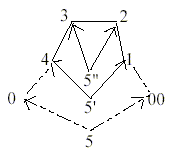
b. The pentagon:
Connecting all corners in a pentagon creates a new inner
pentagon, drawing all diagonals in this gives a third "deeper"
pentagon etc. It could perhaps illustrate the principle
of levels in the grammatical, geometrical differentiations
within word classes, even if some diagonals seem inadequate.
(A hexagon with all corners connected gives an inner hexagon,
the same principle.)
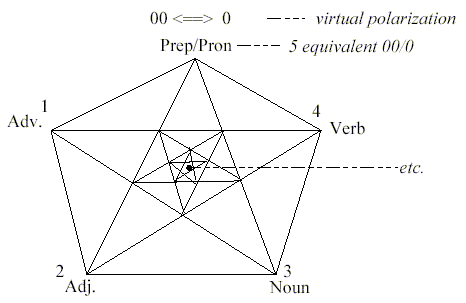
Number of connections
if all corners were connected with one another:
1 level: 5 x 4 / 2 = 10
2 levels: 52 x 24/2 = 300
3 levels: 53 x 124/2 = 7750
(Cf. circa 5 types of consonants and average value of numbers
of phonemes in a language about the magnitude of 25 etc.)
*
To Language
families
|



 )
)


